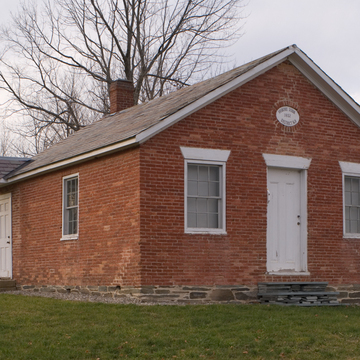During the wool-growing boom of the second quarter of the nineteenth century, Pawlet farms prospered, raising over twenty thousand sheep on their rocky hillsides, while five fulling mills, two carding machines, and four woolen factories on the Mettowee River and Flower Brook made use of their fleeces. One expression of the prosperity was that between 1840 and 1860 all of the town's district schools were rebuilt, at least four of them in brick. Thanks to the Pawlet Historical Society, this one-story, one-room, brick schoolhouse is the best preserved in Pawlet, and one of the finest examples remaining in the state. With a very conservative, almost Federal appearance similar to the brick district school (1818) that remains in Wallingford village, the front has a central entrance with a six-over-six window with a splayed stone lintel on each side. A wood-frame outhouse ell and a wood shed are attached at the right rear. Four large adjoining two-over-two windows were added in the rear gable end shortly after 1904, when the Vermont legislature required additional lighting in district schools. The school remained in use until 1934, when a declining population led to its closure, along with several other district schools.
You are here
Braintree District No. 8 School
If SAH Archipedia has been useful to you, please consider supporting it.
SAH Archipedia tells the story of the United States through its buildings, landscapes, and cities. This freely available resource empowers the public with authoritative knowledge that deepens their understanding and appreciation of the built environment. But the Society of Architectural Historians, which created SAH Archipedia with University of Virginia Press, needs your support to maintain the high-caliber research, writing, photography, cartography, editing, design, and programming that make SAH Archipedia a trusted online resource available to all who value the history of place, heritage tourism, and learning.















